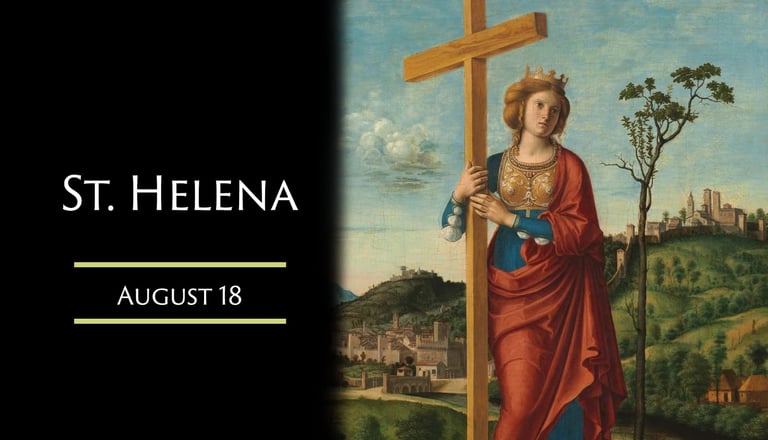Saint of the day August 18, 2025
St. Helena
DAILY SAINT
Nirmala Josephine
8/18/20253 min read


Helena, born circa 250 AD in Bithynia, a region within modern-day Turkey, hailed from a pagan lineage of modest beginnings. Despite her humble origins, her innate grace and humility captivated Constantius Chlorus, a man destined for imperial power. From their union was born Constantine, the future emperor who would indelibly alter the course of Christian history.
When Constantius Chlorus ascended to the rank of Caesar within the Tetrarchy system, he was compelled to repudiate Helena in favor of marriage to Theodora, the stepdaughter of Emperor Maximian. This marked the onset of a challenging period for Helena, who, though cast aside from the court and separated from her son, did not succumb to despair. She embraced her fate with quiet dignity, finding solace and strength in her newfound faith, which fortified her to confront life's adversities.
Following Constantius Chlorus's elevation to head of the Empire, Constantine accompanied him to Britannia. After his father's demise, Constantine was proclaimed emperor by the legions, and one of his inaugural acts was to summon his mother back to court, bestowing upon her the title of Augusta. Despite the newfound prestige, Saint Helena remained untainted by power's allure, dedicating her life to aiding the destitute, liberating prisoners, and assisting those in exile.
It is noteworthy how Helena's profound piety played a crucial role in her son's conversion to Christianity. Under her influence, Constantine promulgated the Edict of Milan in 313 AD, which enshrined religious freedom throughout the Roman Empire and brought an end to the persecution of Christians.
In 326 AD, Constantine, driven by motives still debated among historians, decreed the execution of his son Crispus and later his second wife, Fausta, suspected of conspiracy. These calamitous events deeply unsettled the imperial court, plunging Helena into a state of deep sorrow.
Nonetheless, Helena's faith remained unshaken; she redoubled her religious devotion and embarked on a pilgrimage to the Holy Land in search of the relics associated with Christ's Passion. Helena was instrumental in erecting churches at sacred sites, including the Basilica of the Holy Sepulchre in Jerusalem, transforming the Holy Land into a nexus of pilgrimage for Christians from all corners of the globe.
The crowning moment of her pilgrimage was the discovery of the True Cross at Golgotha, an event that, according to tradition, was accompanied by a miraculous occurrence—a man was revived after being placed upon the sacred relic. This discovery not only fortified Christian faith but also bolstered Constantine's rule, imbuing his imperial authority with a symbol of divine sanction.
Following the unearthing of the True Cross, Helena gifted the three nails that had pierced Christ to Constantine. One of these was embedded in the Iron Crown, housed in the Cathedral of Monza, symbolizing that every sovereign must bow to divine will. The relics of the True Cross now reside in the Basilica of Santa Croce in Gerusalemme in Rome, continuing to serve as a potent symbol of faith.
Saint Helena passed away in 329 AD at the age of 80 and was interred in Rome in a mausoleum erected in her honor along the Via Labicana. Her legacy of unwavering faith and devotion is venerated to this day by both the Catholic and Orthodox Churches, serving as a paragon of piety for Christians worldwide.
Reflection
Thanks to Helena's revelation, the Cross emerged as the central symbol of Christian faith, emblematic not only of Christ's sacrifice but also of His triumph over death. Relics of the Cross spread across the Christian world, fueling devotion and reinforcing the faith of countless individuals.
Yet the Cross's significance transcends mere religiosity; it also serves as a formidable political instrument. To possess a relic of the Cross was to hold a fragment of divine history, a talisman that conferred earthly power through the sacred.
Today, the Cross of Jesus stands as one of the most universally recognized symbols, its discovery commemorated annually on September 14th during the Feast of the Exaltation of the Holy Cross. For modern Christians, the Cross symbolizes far more than a religious icon; it is a beacon of hope, a sign of redemption, and a call to action, urging believers to live in accordance with Christ's teachings, following the example of love and compassion that Saint Helena exemplified throughout her life.
Through the Cross, each of us can find our own path to redemption, just as Saint Helena did centuries ago.
